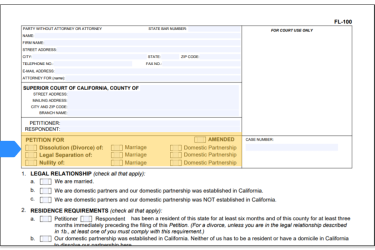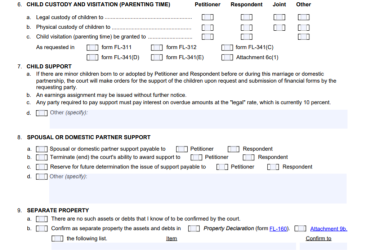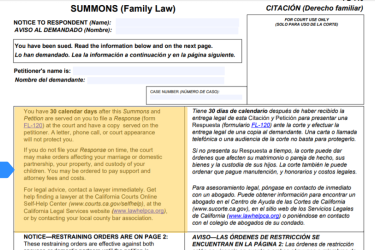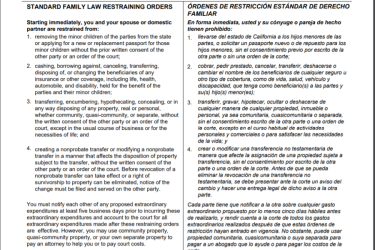What do these papers mean?
Petition and Summons (FL-100 and FL-110)
These papers mean your spouse or partner started a court case to:
-
End your marriage or domestic partnership (divorce)
-
Legally separate you, or
-
Cancel your marriage or partnership (annulment)
This page will help you understand what your spouse wants the court to do and what you can do next.
Jump to section:

What your spouse is asking for
Your spouse chose one of these options:
-
Divorce (dissolution): They want to legally end your marriage or partnership. When the case is done, you’ll be single.
-
Legal separation: They don’t want to end the marriage now, but want your money and property to be separate. Learn more about legal separation.
-
Annulment: They want the court to say your marriage or partnership was never valid. Learn more about annulments.

What your spouse wants the court to decide
Your spouse also checked boxes on pages 2-3 of the Petition to tell the court what they want.
They may have asked the court to decide things like:
-
How to divide your property or debts
-
If one of you should get spousal or partner support
-
Who takes care of your children and how much support to pay
You can tell the court what you want by filing a Response (form FL-120) (opens in a new tab).
If you don’t respond, your spouse can ask the court to decide without hearing from you.

How to respond and what happens if you don't
📅 You have 30 days after you get the papers to file your Response (form FL-120).
If you don't respond in 30 days:
⚠️ Your spouse can ask the court to move forward without you.
This is called a default.
The court can:
-
End your marriage or partnership
-
Divide your property and debts
-
Make custody and support orders
-
Order you to pay support or attorney’s fees
📌 If it’s been more than 30 days but your spouse has not asked for a default yet, you can still file a Response.
✅ File a Response (form FL-120) (opens in a new tab)

Things you can't do now
Once you’re served with the Summons and Petition, there are things you can’t do without a written agreement from your spouse or permission from the court. These are called Standard Family Law Restraining Orders.
You can’t:
-
Hide, sell, or give away money or property
-
Change who’s listed on insurance or retirement accounts
-
Take your children out of California or get them a new passport without permission
These same rules apply to your spouse.
Read page 2 of the Summons (form FL-110) (opens in new tab) to see all the rules.
What to do next
1. Decide if you’ll respond within 30 days
If you respond, you’ll be part of the case and can tell the court what you want.
You and your spouse might agree on everything and not need to go to court.
If you don’t agree, a judge will make the final decision.
If you don’t respond within 30 days, your spouse can ask for a default, and the court can decide without hearing from you.
2. If you already have a written agreement
You don’t have to respond if you and your spouse already have a signed written agreement.
This is called a default with an agreement.
Your spouse will turn in your agreement and other required papers to the court.
The judge will review them and make court orders that match your agreement.
💬 Get help
You can get free legal information from your court’s self-help center.
They can help you understand what to do and how to fill out forms.
-
Find your local self-help center for free legal information.
If you have a lot of property, debt, or a complicated case, you may want to hire a lawyer for all or part of your case.
Key takeaways
- You have 30 days to respond after getting the Petition and Summons.
- Read page 2 of the Summons for rules about what you can’t do.
- If you already have a written agreement, you may not need to respond.
- You can get free help from your court’s self-help center.
Divorce
What's next?
-
Respond to the divorce papers
Get step-by-step instructions for how to respond to divorce papers and participate in the divorce process.
-
Don’t respond because you already have an agreement
Learn more about default with an agreement. The court will decide the case based on the information your spouse provides, which includes your agreement.
-
Do nothing
Learn more about a default. This means your spouse can move the case forward without your input.

